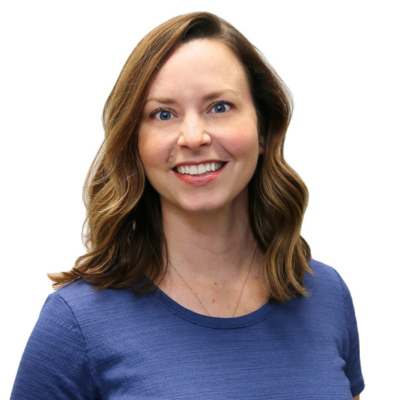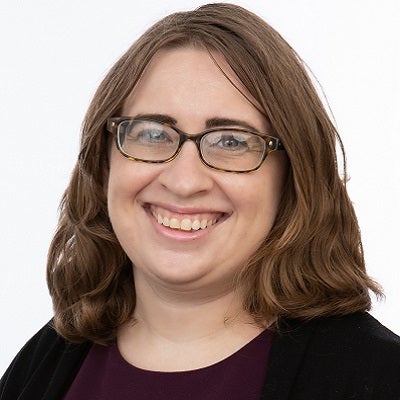April 2025 State of Our Children 360 Newsletter
In this month's edition, get an in-depth look and perspectives from subject matter experts about child development and how developmental surveillance and screening can help parents become active members of their child's care team, working together with pediatricians and early education and intervention specialists to provide the best care for young children.
Articles in this issue:
- Developmental Surveillance and Screening
- Wading through the Alphabet Soup of Services: How to Get Kids the Services They Need
- The Foundation of Success: How Early Childhood Education Shapes Lifelong Learning
- Additional Resources
Developmental Surveillance and Screening
Erin Vaughn, MD, FAAP | Complex Pediatrics, Core Faculty Valley Children’s Hospital Residency
 When one thinks of “surveillance,” a detective camped out in a car, drinking coffee and watching a suspect through long range binoculars may come to mind. It is very unlikely one may think of childhood developmental milestones. But as pediatricians, educators and community service providers, we need to be in that same vigilant state, with our metaphorical binoculars, searching for signs of developmental delays. One in 6 children between the ages 3 and 17 have developmental disabilities -- conditions that affect how children learn, move speak and act. Unfortunately, many children with developmental disabilities are not identified until starting school, despite research showing that early intervention can significantly improve outcomes in children with delays.
When one thinks of “surveillance,” a detective camped out in a car, drinking coffee and watching a suspect through long range binoculars may come to mind. It is very unlikely one may think of childhood developmental milestones. But as pediatricians, educators and community service providers, we need to be in that same vigilant state, with our metaphorical binoculars, searching for signs of developmental delays. One in 6 children between the ages 3 and 17 have developmental disabilities -- conditions that affect how children learn, move speak and act. Unfortunately, many children with developmental disabilities are not identified until starting school, despite research showing that early intervention can significantly improve outcomes in children with delays.
Developmental surveillance, or monitoring, is an ongoing practice in which educators and medical professionals identify children at risk for developmental delays. It should occur at every well-child visit but can also occur at other doctor visits or in the classroom. It entails eliciting parental concerns about development, getting a developmental history and observing the child for signs of delays. Once delays are identified, the child should undergo further evaluation. Unfortunately, surveillance alone can miss children with delays. Parents may not be aware of developmental milestones and thus will not have concerns about development. Clinicians and educators may not have a chance to observe children for a long enough period or in the right settings to identify developmental delays.
Developmental screening uses standardized, validated measures that can identify the delays that can potentially be missed by surveillance. The American Academy of Pediatrics (AAP) recommends general developmental screening at the 9-, 18- and 30-month well child visits, as well as autism screening at 18- and 24-month visits. They can also be used at any time to collect more information about a child in whom developmental concerns have been identified. It’s important to remember that surveillance and screening each serve an important function and cannot take the place of the other. Used together, surveillance and screening ensure that children with developmental delays don’t fall through the cracks.
There are a lot of great resources available to help providers and educators monitor early childhood development, educate parents and act when concerns are identified. “Learn the Signs. Act Early.” is a program through the Center for Disease Control and Prevention Program that provides online and printed materials for parents, educators and healthcare providers on developmental milestones, including a free Milestone Tracker mobile app for parents. Once developmental concerns are identified, families can feel overwhelmed by navigating the system of developmental evaluations and early intervention. The AAP has also developed a “Family Friendly Referral Guide” which can be personalized to the child’s needs and gives step by step instructions on accessing resources in the area.
Make sure you and your staff are educated on early childhood developmental milestones, get out your binoculars, and stay on the alert for developmental delays! Becoming a developmental detective in your community will make a positive difference in the lives of children of the Central Valley.

About the Author
Dr. Erin Vaughn is a complex care pediatrician at the Charlie Mitchell Children's Center located on Valley Children's Hospital's main campus in Madera. She is a passionate advocate for her patients and values the role she can play in helping educate and empower patients and their families. In addition to her clinical duties, she is a core faculty member of Valley Children’s Hospital Pediatric Residency Program.
Learn more about Dr. Vaughn
Wading through the Alphabet Soup of Services: How to Get Kids the Services they Need
Jennifer Johnson, MD | Developmental-Behavioral Pediatrician, Valley Children's Healthcare
 IEP, CCS, SSI, ABA, ST, IHSS, DIR, SAI, IFSP, SDC, AAC, PT, OT, FBA, BIP, APE, ASD, IDEA — it’s easy to see how parents and healthcare providers can get lost in the alphabet soup of services. Although recognizing that a child has a developmental delay can be a challenge, the bigger challenge for many providers is figuring out what to do about the concerns, especially in a resource-limited region. It can be difficult to navigate the multiple systems involved, such as early intervention/regional centers, the medical/insurance system and the school district – all of which typically conduct their own evaluations and provide services, but rarely interact or communicate between their systems.
IEP, CCS, SSI, ABA, ST, IHSS, DIR, SAI, IFSP, SDC, AAC, PT, OT, FBA, BIP, APE, ASD, IDEA — it’s easy to see how parents and healthcare providers can get lost in the alphabet soup of services. Although recognizing that a child has a developmental delay can be a challenge, the bigger challenge for many providers is figuring out what to do about the concerns, especially in a resource-limited region. It can be difficult to navigate the multiple systems involved, such as early intervention/regional centers, the medical/insurance system and the school district – all of which typically conduct their own evaluations and provide services, but rarely interact or communicate between their systems.
About one in six children over the age of 3 years goes on to be diagnosed with a neurodevelopmental disability, such as autism, ADHD, or intellectual disability. Approximately one in six children over the age of 3 years old is diagnosed with a neurodevelopmental condition, such as autism, ADHD or intellectual disability. Developmental disabilities start in the early developmental period and typically last throughout the lifetime. While some causes or risk factors are identifiable, such as in-utero infections or exposures, prematurity or genetic disorders, the cause of many of these conditions remains unknown. As children’s brains are most adaptable in the first three years of life, it is essential to identify and treat these conditions as early as possible. Given the prevalence of these conditions, it is just not feasible to defer care of these conditions to specialists. So, what role can you play to make a difference?
Know the Federal and State Resources
Given the specificity and ever-changing nature of local resources, it is typically more helpful for providers to know the federal and state resources available that operate locally. The Individuals with Disabilities Education Act (IDEA) laid out two paths to services that are available in every state: early intervention services for the 0–36-month-old population and special education services for the 3–21-year-old population.
In California, early intervention evaluation and services are administered through 21 regional centers. Children qualify for services if they are at least 25% delayed in one or more areas of development, have a diagnosed risk condition (such as a genetic syndrome like trisomy 21), or are at high risk of for a developmental disability (premature, in utero exposures, parent with a developmental disability etc.). Anyone can make a referral for evaluation, including the child’s parents. Within 45 days of referral, the child should be assessed and referred for necessary services, such as speech therapy, occupational therapy or applied behavioral analysis (ABA) therapy. Before turning 3 years old, the child should receive evaluations through both the regional center and the school district to determine qualification and ongoing services that will be needed.
Over 3 years old, services are primarily provided by the public school system. Children should qualify for special education services through their local school district if they meet criteria for at least one qualifying condition that significantly impacts their education. Although documentation from a medical provider or teacher can be helpful, a recommendation is not required to evaluate children for an individualized educational plan (IEP). Parents should be counseled to write a short note to be submitted to the head of special education documenting their concerns and requesting that their child be evaluated for an IEP. Once submitted, the child should be assessed and an IEP meeting held to discuss what services are needed within 60 days. These evaluations and some of these services are available even if the child is not yet attending school, attends private school or is homeschooled.
Specific to California, the Lanterman Act laid out additional, lifelong supports for those with developmental disabilities. These supports are accessed through the same regional centers that provide early intervention services. If a person has autism, intellectual disability, cerebral palsy, severe epilepsy or a condition requiring similar support to these conditions, they may qualify for regional center services. The goal of these services is to help those with developmental disabilities exercise independence and thrive at home and in their communities. They provide case management services and access to services that are not covered through the school or insurance, such as Medi-Cal waivers, community activities and adult day programs.
Develop a Pathway
The good news for providers is that they do not have to reinvent the wheel for each patient identified by developmental monitoring and screening. If concern for a delay arises during a visit, it is helpful to collect further information by administering a developmental screener like the Ages and Stage Questionnaire (ASQ). If the child has language or social delays, a formal audiology evaluation is indicated to rule out more subtle deficits than will be noticed in-office evaluations. Additionally, a head circumference measurement, office vision screening and lead testing should be completed if delays are noted. If under 3 years old, refer the child to their local regional center for further evaluation and services. If 3 years or older, those with possible delays should be directed to their local school district for an IEP evaluation; private services through insurance could also be considered. Although the school district cannot make a medical diagnosis, the child should be referred to a regional center if educational criteria is met for intellectual disability or autism in order to receive a diagnostic evaluation.
Encourage Family Engagement
The biggest factor in a child’s development and their future outcomes is family engagement. Children learn best when interacting with other people. Reading, talking and singing with children helps develop their language skills, and playing with them helps develop their motor, cognitive and social skills. Interaction helps build pathways that lead to further development. Letting parents know that they have the biggest impact on their child’s outcomes can be empowering.
For more information on activities to encourage development through play and interaction, go to https://agesandstages.com/resource/asq-learning-activity-handouts/ or https://pathways.org/.

About the Author
As a board-certified developmental-behavioral pediatrician, Dr. Jennifer Johnson specializes in autism, ADHD and pediatric mental health, with a strong focus on research and advocacy. Her work examining the intersection of home environment, education and mental health, along with her experience mentoring and training future physicians, reinforces her expertise in comprehensive developmental care.
Learn more about Dr. JohnsonThe Foundation of Success: How Early Childhood Education Shapes Lifelong Learning
Lorena Castillo, MBA | Tulare County of Early Education
 Early childhood education is an essential piece in ensuring children have the tools they need to be successful in school and far into adulthood. Studies show that 90% of a child’s brain develops before the age of 5 and 80% of a child’s brain develops by age 3. This lets us know how crucial these early years are for a child’s development and the impact that a high-quality early childhood experience can have for these young learners.
Early childhood education is an essential piece in ensuring children have the tools they need to be successful in school and far into adulthood. Studies show that 90% of a child’s brain develops before the age of 5 and 80% of a child’s brain develops by age 3. This lets us know how crucial these early years are for a child’s development and the impact that a high-quality early childhood experience can have for these young learners.
Ensuring children are ready for kindergarten begins with staying on track of developmental milestones. Many early education programs conduct developmental screenings to assist in identifying areas of potential growth for a child. This approach assists in getting children the resources and support they may need for early intervention and provides the building blocks for future success. An example of a screening tool commonly used within our community is the Ages and Stages Questionnaire-3 (ASQ-3), as well as the Ages and Stages Questionnaire: Social Emotional-2 (ASQ:SE-2). The ASQ-3 measures five developmental domains which are communication, gross motor, fine motor, problem solving and personal social. The ASQ:SE-2 is a screening tool for social emotional development.
Early childhood education programs typically conduct screening tools such as the ASQ’s at the start of the school year. Many of these tools are conducted in combination with the child’s parent or caregiver to warrant a more accurate result. The results allow the early education program and families to discuss possible areas of concern and create a plan to assist. These plans can be as simple as a new assessment is needed, offering additional classroom support or referring the family to an appropriate agency for early intervention services.
Early intervention has proven to be the foundation for healthy child development. According to the National Library of Medicine, “Early intervention programs has shown to increase the overall socio-emotional and physical wellbeing of children in early childhood and educational settings.” As such, early childhood programs that utilize screening tools do so with a deep understanding of the significance in identifying children’s needs early and the impact it can have on a child’s life.
Furthermore, to continue to support children’s development and school readiness, early education programs may also utilize child observation tools to measure children’s developmental progress throughout the school year. In California, certain early education programs may be required to use a specific tool, known as the Desired Results Developmental Profile 2015 (DRDP-2015). “The DRDP is an assessment that teachers use to gather information to support children’s learning and development”-Desired Results Access Project.
The DRDP (2015) assessment tool assesses a child’s development in eight domains. The first domain is an approach to learning-self regulation; it refers to children calming themselves, recognizing their emotions and using strategies to meet their needs. The other seven domains are: social and emotional, language and literacy, English language development, cognition math, cognition science, physical development-health, history and social science and visual performing arts. Teachers assess children in these domains, at a minimum of twice a year to track the child’s development across all eight domains. The result of this assessment is intended to be used by teachers to assist in planning developmentally age-appropriate curriculum and activities tailored to children’s individual needs. The results of this assessment are also shared with the children’s families.
Early screening, identification and intervention in arrangement with the utilization of observation tools such as the DRDP (2015) and ongoing child assessments assist early education programs in properly preparing children for school and lifetime success. Being able to have a holistic view of a child’s overall development has proven to be extremely beneficial in assisting children with meeting their developmental milestones, in years which are so critical in their overall lifetime.
One of the goals in early education is to have learners that are both school ready and socially ready to overcome obstacles from the early years and far beyond. This would not be possible without providing the early support that each child needs and rightfully deserves.
References

About the Author
Lorena Castillo, MBA, is an assistant administrator for Tulare County Office of Education - Early Education.
Additional Resources

Developmental Milestones App
The CDC offers a free Developmental Milestones app in English and Spanish. Encourage parents to download so they can be an active — and proactive — participant in their child's developmental surveillance and screening.
Learn more
Prescription for Play
Dr. Michael Yogman of the American Academy of Pediatrics (AAP) writes that for kids, play is more than just having fun. From improving a child's abilities to organize, building social skills and regulating emotions, a prescription for play is not only fun, it's good medicine.
Read the article